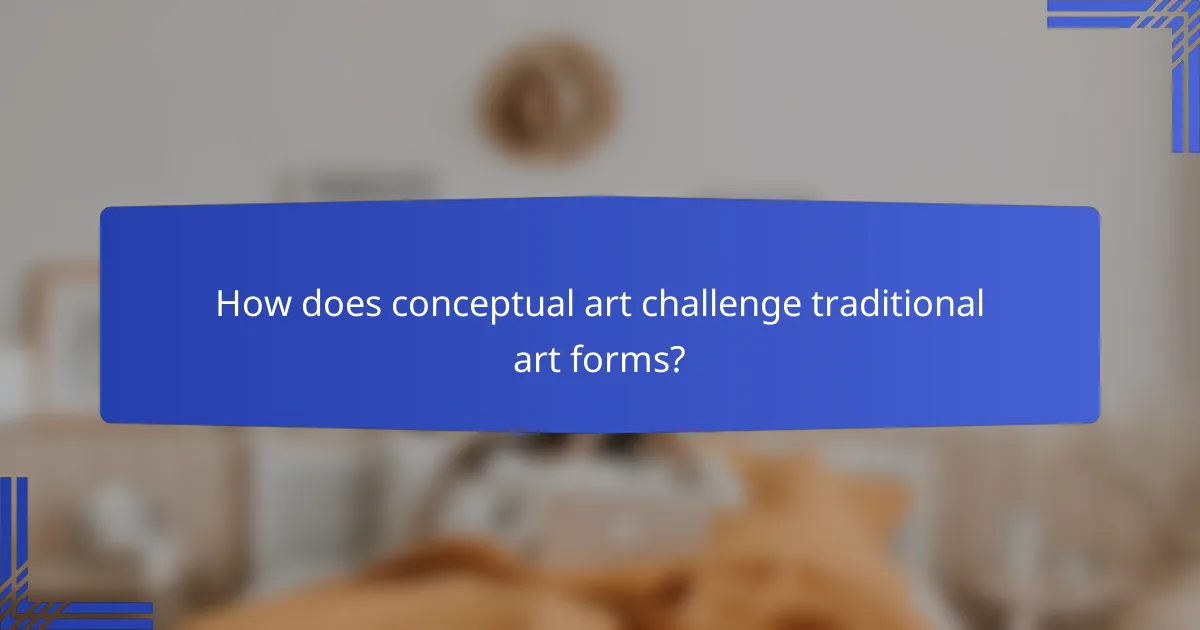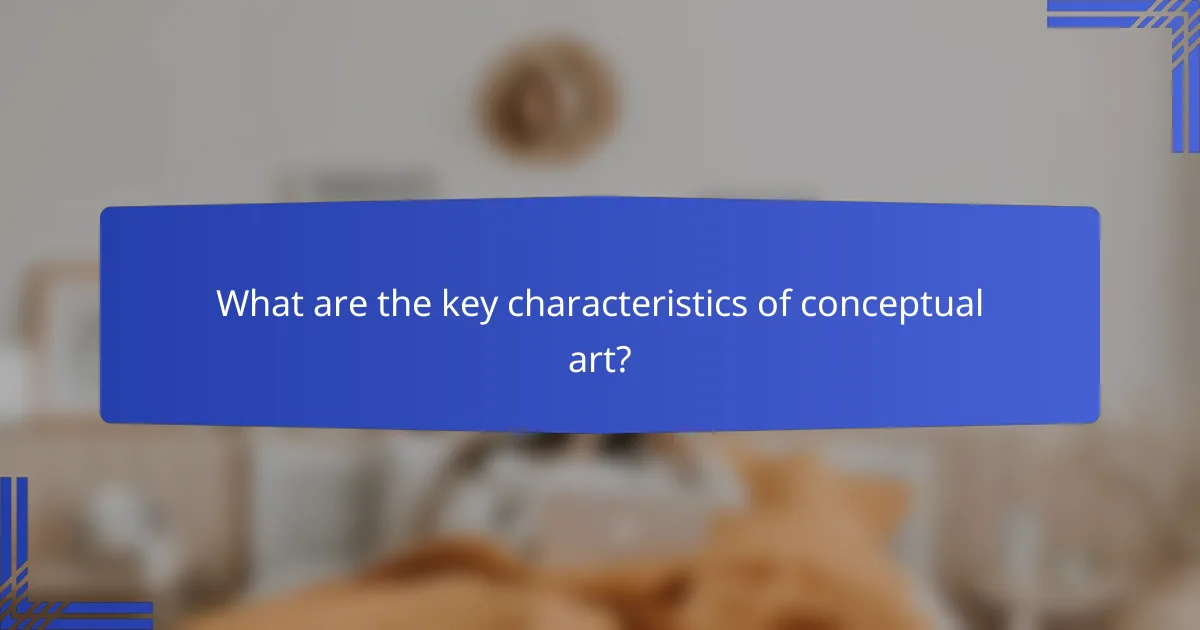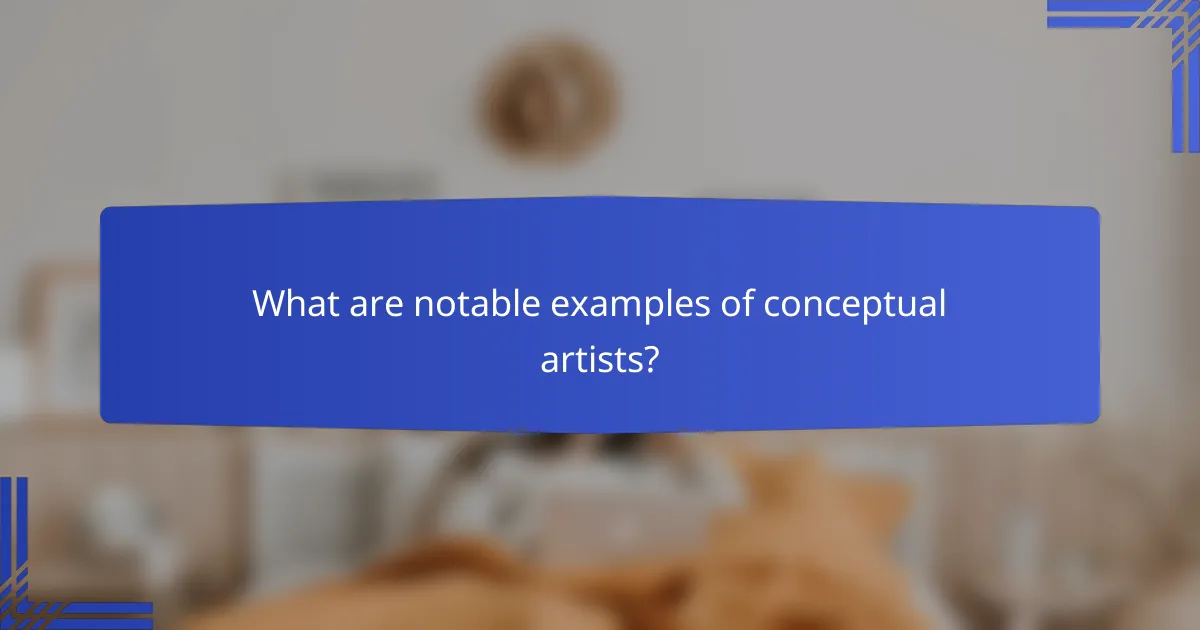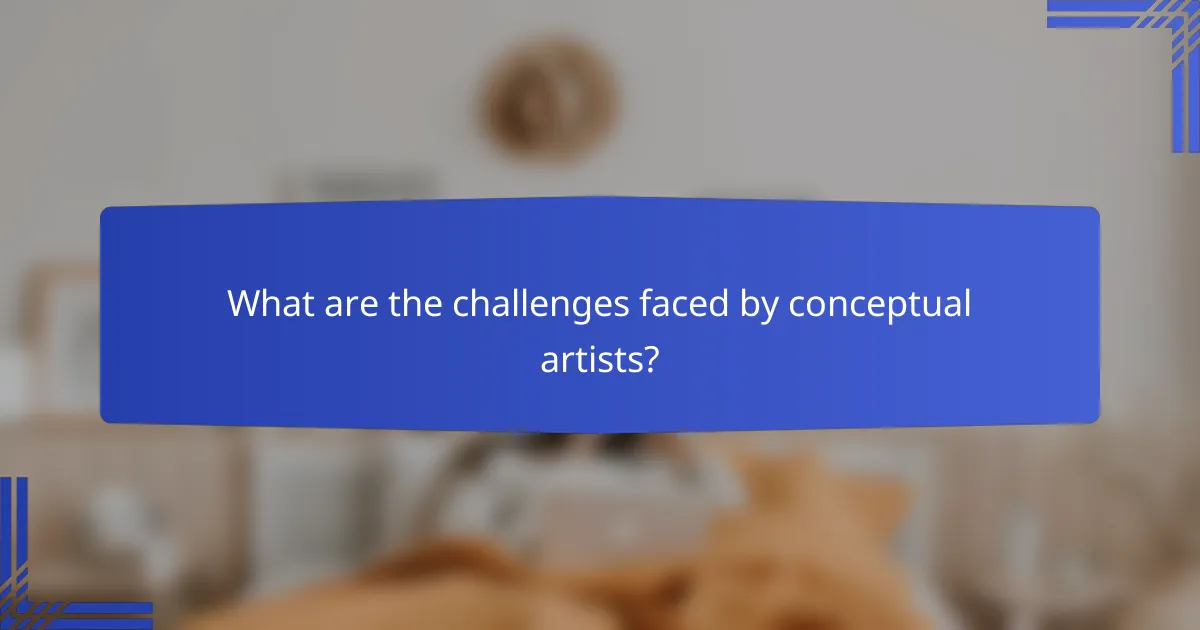Conceptual art redefines the boundaries of artistic expression by emphasizing ideas and concepts over traditional aesthetics and craftsmanship. This innovative approach invites viewers to engage with the artwork on a personal level, encouraging diverse interpretations shaped by individual perspectives and experiences.

How does conceptual art challenge traditional art forms?
Conceptual art challenges traditional art forms by prioritizing ideas and concepts over aesthetic value and craftsmanship. This shift encourages artists to explore new mediums and engage viewers in a more interactive and interpretative experience.
Focus on ideas over aesthetics
In conceptual art, the primary focus is on the underlying ideas rather than the visual appeal. Artists often use text, performance, or installations to convey their messages, making the concept itself the artwork. This approach can lead to pieces that provoke thought and discussion, even if they lack traditional beauty.
For instance, works like Marcel Duchamp’s “Fountain,” a urinal presented as art, challenge viewers to reconsider what constitutes art. This idea-centric focus can sometimes alienate those who expect traditional craftsmanship but opens up new avenues for artistic expression.
Use of non-traditional mediums
Conceptual artists frequently employ non-traditional mediums, such as video, sound, and everyday objects, to convey their messages. This use of diverse materials allows for innovative expressions that traditional art forms may not accommodate. For example, installations might incorporate technology or community participation, creating a dynamic experience for the audience.
By breaking away from paint and canvas, artists can explore concepts in ways that resonate more deeply with contemporary issues. This flexibility encourages experimentation and can lead to unexpected interpretations of the work.
Encourages viewer interpretation
Conceptual art actively invites viewer interpretation, making the audience an integral part of the artwork. Unlike traditional pieces that often convey a single narrative, conceptual works can have multiple meanings based on individual perspectives. This openness fosters dialogue and personal engagement with the art.
For example, a conceptual installation might use ambiguous symbols or incomplete narratives, prompting viewers to reflect on their own experiences and beliefs. This interaction can transform the viewing experience into a collaborative exploration of ideas, enhancing the overall impact of the artwork.

What are the key characteristics of conceptual art?
Conceptual art prioritizes ideas over traditional aesthetic values, focusing on the concept behind the work rather than the final product. This approach encourages diverse interpretations from viewers, making the context and medium just as significant as the artwork itself.
Idea-driven creations
At the heart of conceptual art are the ideas that inspire the work. Artists often start with a concept they wish to explore, which can range from social commentary to philosophical questions. The execution of the piece is secondary to the message it conveys, allowing for a wide array of interpretations.
For instance, an artist might create a piece that challenges societal norms or provokes thought about personal identity. The focus remains on the viewer’s engagement with the concept rather than the visual appeal of the work.
Emphasis on context
Context plays a crucial role in conceptual art, as it shapes how the work is perceived and understood. The environment in which the art is displayed, along with the artist’s background and intent, can significantly influence interpretation. This means that the same piece can evoke different reactions depending on where and how it is presented.
For example, a conceptual artwork displayed in a gallery may carry different connotations than the same piece shown in a public space. Understanding the context can enhance the viewer’s experience and deepen their engagement with the work.
Variety of mediums used
Conceptual artists utilize a broad spectrum of mediums, often choosing those that best express their ideas. This can include traditional forms like painting and sculpture, as well as non-traditional mediums such as performance art, installations, and digital media. The choice of medium is often driven by how effectively it can convey the intended message.
For instance, an installation might use everyday objects to challenge perceptions of consumerism, while a performance piece could explore themes of identity through live interaction. This diversity allows conceptual art to reach a wider audience and engage them in unique ways.

How can viewers interpret conceptual art?
Viewers interpret conceptual art through their personal perspectives and experiences, which significantly shape their understanding of the artwork. This interpretation often varies widely, as each individual brings unique insights and emotions to the viewing experience.
Personal experiences shape understanding
Each viewer’s background, emotions, and life experiences play a crucial role in how they perceive conceptual art. For instance, someone who has experienced loss may interpret a piece about absence differently than someone who has not. This personal lens can lead to diverse interpretations, making the artwork resonate on various emotional levels.
Artworks that evoke strong memories or feelings can prompt viewers to connect deeply, often leading to a more profound appreciation. Engaging with art that reflects personal experiences can foster a sense of belonging and understanding, enhancing the overall impact of the piece.
Contextual knowledge influences perception
Contextual knowledge, including historical, cultural, and social backgrounds, significantly affects how viewers interpret conceptual art. Understanding the artist’s intent, the cultural significance of the medium, or the historical context can provide valuable insights that enrich the viewing experience. For example, knowing the socio-political climate during the creation of a piece can alter its perceived meaning.
Additionally, familiarity with art movements and styles can guide viewers in recognizing references or critiques embedded within the work. Engaging with educational resources, such as gallery talks or art criticism, can enhance one’s ability to interpret and appreciate conceptual art more fully.

What are notable examples of conceptual artists?
Notable examples of conceptual artists include Marcel Duchamp, Sol LeWitt, and Yoko Ono, each of whom has significantly influenced the art world by prioritizing ideas over traditional aesthetics. Their works challenge conventional notions of art and encourage viewers to engage with the underlying concepts.
Marcel Duchamp
Marcel Duchamp is often regarded as a pioneer of conceptual art, best known for his readymades, which are ordinary objects presented as art. His most famous piece, “Fountain,” is a urinal that questions the definition of art and the role of the artist. Duchamp’s work emphasizes the importance of the idea behind the artwork rather than its physical form.
When exploring Duchamp’s influence, consider how he shifted the focus from craftsmanship to intellectual engagement. His provocative choices encourage viewers to rethink their perceptions of art and its context.
Sol LeWitt
Sol LeWitt is celebrated for his wall drawings and structures that embody the principles of conceptual art. He believed that the idea or concept behind a work was more significant than its execution, often providing detailed instructions for others to create his pieces. This approach democratizes art-making, allowing anyone to realize his vision.
LeWitt’s work invites viewers to appreciate the process and thought involved in art creation. His emphasis on the concept over the physical artwork encourages a deeper understanding of artistic intent and interpretation.
Yoko Ono
Yoko Ono is known for her avant-garde conceptual art that often incorporates performance and audience participation. Her work, such as “Cut Piece,” challenges viewers to engage actively with the art, blurring the lines between artist and audience. Ono’s pieces often explore themes of peace, feminism, and social issues.
When engaging with Ono’s art, consider the role of interaction and the emotional responses elicited from participants. Her work emphasizes the transformative power of art as a medium for social commentary and personal reflection.

What role does conceptual art play in contemporary galleries in London?
Conceptual art plays a significant role in contemporary galleries in London by challenging traditional notions of art and emphasizing the idea behind the work rather than its aesthetic value. This approach invites viewers to engage with the concepts presented, fostering a deeper interpretation and discussion around the art itself.
Showcases innovative practices
Contemporary galleries in London often showcase conceptual art that utilizes non-traditional mediums, such as installations, performance art, and digital formats. This diversity allows artists to explore new ideas and methods, pushing the boundaries of what art can be. For example, installations might incorporate everyday objects or technology, prompting viewers to reconsider their perceptions of art and its role in society.
Many galleries host exhibitions that focus on specific themes or social issues, encouraging artists to create works that respond to current events or cultural dialogues. This not only highlights innovative practices but also positions conceptual art as a relevant and dynamic force within the contemporary art scene.
Engages diverse audiences
Conceptual art in London galleries engages a wide range of audiences by inviting personal interpretation and emotional responses. Unlike traditional art forms that may rely on technical skill or beauty, conceptual art encourages viewers to think critically about the ideas presented. This open-ended nature can attract individuals from various backgrounds, including those who may not typically identify as art enthusiasts.
Galleries often facilitate discussions, workshops, and guided tours that enhance audience engagement with conceptual works. These initiatives help demystify the art, making it accessible and relatable. By fostering dialogue around the ideas and themes in conceptual art, galleries can create a more inclusive environment that resonates with a broader public.

What are the challenges faced by conceptual artists?
Conceptual artists encounter various challenges that stem from the nature of their work, which prioritizes ideas over traditional aesthetics. These challenges include viewer interpretation, the use of non-traditional mediums, and the difficulty in conveying complex concepts effectively.
Viewer Interpretation
One of the main challenges for conceptual artists is the subjective nature of viewer interpretation. Each individual may perceive a piece differently based on personal experiences and cultural backgrounds, leading to a wide range of interpretations that may not align with the artist’s original intent.
To mitigate misunderstandings, artists often provide context through titles, descriptions, or accompanying materials. However, this can also limit the viewer’s freedom to engage with the work, creating a delicate balance between guidance and openness.
Non-Traditional Mediums
Conceptual artists frequently utilize non-traditional mediums, which can pose logistical and practical challenges. Materials such as found objects, digital media, or performance art require unique handling, storage, and presentation methods, which may not be readily available or easily accessible.
Artists must also consider the durability and longevity of these materials, as some may degrade over time or require specific environmental conditions. This adds an additional layer of complexity to the creation and exhibition of their work.
Conveying Complex Concepts
Effectively conveying complex concepts is another significant challenge for conceptual artists. The ideas behind their work can be abstract or multifaceted, making it difficult to communicate them clearly to a diverse audience.
To address this, artists might use visual aids, interactive elements, or supplementary texts to enhance understanding. However, there is a risk that over-explaining can detract from the artwork’s impact, so finding the right balance is crucial.
